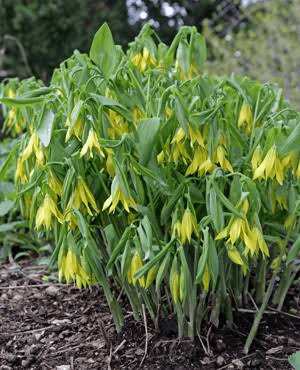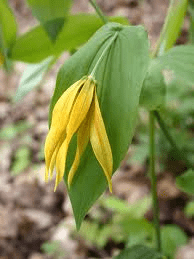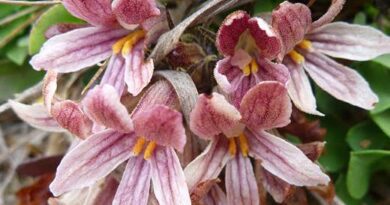10 Medicinal Health Benefits Of Uvularia grandiflora (Large-Flowered Bellwort)
Uvularia grandiflora, commonly known as large-flowered bellwort or merrybells, is a beautiful and delicate wildflower that can be found in the woodlands and forests of North America. This plant is a member of the lily family (Liliaceae) and is known for its graceful appearance, large yellow flowers, and slender, arching stems. In this description,
Uvularia grandiflora is a herbaceous perennial plant that typically grows to a height of 1 to 2 feet (30 to 60 cm). The most striking feature of this wildflower is its elegant, pendulous, bell-shaped flowers. These flowers are a rich, pale yellow, and they dangle from the tips of long, slender stems, giving the plant an ethereal and delicate appearance. Each flower typically has six petal-like tepals and a central, elongated structure called a pistil.
The leaves of Uvularia grandiflora are lance-shaped and alternate along the stem. They are typically 3-6 inches (7.5-15 cm) long and have a smooth, dark green surface. The plant’s stem is usually hairless and can have a slight curve or arch, which adds to its aesthetic charm.
Habitat and Distribution
Large-flowered bellwort is native to eastern North America and can be found throughout a wide range of states and provinces, including parts of the United States and Canada. It is commonly encountered in deciduous woodlands, moist forests, and shady, low-lying areas.
This wildflower thrives in rich, well-drained soils, often found in close proximity to water sources such as streams and creeks. Its preference for shaded environments makes it a common sight in the understory of hardwood forests.
Ecological Importance
Uvularia grandiflora plays a significant role in the ecosystems where it is found. As a native wildflower, it provides nectar and pollen for various pollinators, including bees and butterflies. In particular, its bell-shaped flowers are well-suited for long-tongued bees that can reach the nectar hidden deep within the flower’s structure. These pollinators are crucial for the reproduction and genetic diversity of the plant.
Furthermore, the presence of large-flowered bellwort in the forest understory can have a positive impact on the overall biodiversity of the ecosystem. It offers protection and habitat for smaller creatures, such as insects and small mammals. In the fall, the plant’s seeds provide a source of food for wildlife, contributing to the forest’s food web.
Cultural Significance
Uvularia grandiflora has cultural significance in some Native American traditions. Indigenous communities have used various parts of the plant for medicinal and ceremonial purposes. For instance, some tribes utilized the roots of large-flowered bellwort to create infusions believed to have medicinal properties, often used for treating coughs and respiratory ailments. The plant’s use in traditional medicine reflects its cultural importance and the valuable knowledge of indigenous peoples regarding the natural world.
In contemporary times, Uvularia grandiflora is highly regarded by wildflower enthusiasts, horticulturists, and gardeners for its delicate beauty. It is often sought after as an ornamental plant in woodland gardens and shaded landscapes. Cultivating this native species in home gardens not only enhances the aesthetic appeal of the space but also contributes to the conservation of native plant species.
Conservation Status
While Uvularia grandiflora is not considered endangered, it is essential to conserve and protect native wildflower species like this one. Habitat loss and invasive species are ongoing threats to the plant’s survival. To ensure the continued presence of large-flowered bellwort in its natural habitats, conservation efforts should focus on preserving woodlands, forests, and the ecosystems that support this beautiful wildflower.
The Botanical Description of Uvularia grandiflora
Uvularia grandiflora, commonly known as large-flowered bellwort, is a perennial herbaceous plant belonging to the family Colchicaceae. This elegant plant is characterized by its distinctive bell-shaped flowers and lance-shaped leaves.
1. Size and Structure: Uvularia grandiflora typically grows to a height of 12 to 24 inches (30 to 60 cm) and features slender, arching stems. The leaves are alternate, elongated, and pointed, measuring about 3 to 6 inches (7.6 to 15.2 cm) in length. These lance-shaped leaves are arranged along the stem and add to the plant’s overall gracefulness. The most striking feature of Uvularia grandiflora is its bell-shaped flowers, which hang delicately from the stem. Each flower has six petal-like tepals that are pale yellow or cream in color, giving the plant a subtle yet enchanting appearance.
2. Reproductive Organs: One of the notable aspects of Uvularia grandiflora’s botanical structure is its reproductive organs. The plant produces small, urn-shaped flowers that contain both male and female reproductive parts. The presence of these reproductive organs enables the plant to undergo sexual reproduction and produce seeds, ensuring its survival and continuation of the species.
The Geographic Distribution of Uvularia grandiflora
Uvularia grandiflora, or large-flowered bellwort, has a diverse geographic distribution, encompassing various regions across North America. Understanding its range provides valuable insights into the plant’s adaptability and ecological significance.
1. Eastern North America: Uvularia grandiflora is primarily found in the eastern parts of North America, including the eastern United States and southeastern Canada. It thrives in deciduous forests, wooded slopes, and rich, moist soils. States such as Virginia, North Carolina, and Tennessee boast significant populations of this species.
2. Habitat Preference: Large-flowered bellwort prefers habitats with dappled sunlight and well-drained soils. It often grows alongside other woodland plants, creating a harmonious ecosystem within the forest understory. These plants play a crucial role in maintaining the ecological balance of their habitats by providing food and shelter for various animal species.
3. Climate Adaptability: Uvularia grandiflora exhibits adaptability to different climatic conditions within its range. It can withstand moderate fluctuations in temperature and moisture levels, allowing it to thrive in diverse environments. This adaptability contributes to the plant’s widespread distribution across various ecosystems.
4. Conservation Status: While Uvularia grandiflora is not considered globally threatened, localized factors such as habitat loss and deforestation pose potential threats to certain populations. Conservation efforts are essential to preserving the natural habitats where this species resides, ensuring its continued existence for future generations.
The Chemical Composition of Uvularia grandiflora
Exploring the chemical composition of Uvularia grandiflora unveils the intricate compounds and substances that contribute to its unique properties. From phytochemicals to essential compounds, this analysis sheds light on the plant’s medicinal and ecological significance.
1. Alkaloids: Uvularia grandiflora contains various alkaloids, which are nitrogenous organic compounds known for their diverse biological activities. Alkaloids play a crucial role in plant defense mechanisms, deterring herbivores and protecting the plant from potential threats. Some alkaloids found in Uvularia grandiflora have been studied for their potential pharmacological properties, making them of interest to researchers and herbalists alike.
2. Flavonoids: Flavonoids are a group of polyphenolic compounds with antioxidant properties. These compounds contribute to the plant’s vibrant coloration and protect it from oxidative stress. In Uvularia grandiflora, flavonoids are present in various parts of the plant, including the flowers and leaves. The antioxidant properties of flavonoids have been associated with numerous health benefits, making them valuable components of traditional medicine and herbal remedies.
3. Tannins: Tannins are polyphenolic compounds that have astringent properties and are commonly found in plants. Uvularia grandiflora contains tannins, which are responsible for the plant’s slightly bitter taste. These compounds have been studied for their ability to bind to proteins and other organic substances, making them useful in the tanning of leather and the preservation of certain food products. In addition to their industrial applications, tannins also have potential health benefits, such as anti-inflammatory and antimicrobial properties.
4. Saponins: Saponins are glycoside compounds with foaming properties. They are found in various plant species, including Uvularia grandiflora. Saponins have been studied for their potential cholesterol-lowering effects and their ability to enhance the immune system. These compounds also play a role in plant defense mechanisms, protecting the plant from pests and pathogens.
5. Essential Oils: Uvularia grandiflora contains essential oils, which are volatile aromatic compounds responsible for the plant’s characteristic scent. These oils are often extracted from the plant and used in aromatherapy and natural perfumery. The unique fragrance of Uvularia grandiflora essential oil adds to its appeal and makes it a sought-after ingredient in the fragrance indus
The chemical composition of Uvularia grandiflora provides valuable insights into its ecological interactions, medicinal properties, and potential applications in various industries. The presence of alkaloids, flavonoids, tannins, saponins, and essential oils highlights the plant’s complexity and underscores its significance in the natural world. Researchers continue to explore the diverse compounds present in Uvularia grandiflora, unlocking new possibilities for its utilization in medicine, agriculture, and other fields.
Read Also: 7 Medicinal Health Benefits Of Ribes divaricatum (Straggly Gooseberry)
The Medicinal Health Benefits Of Uvularia grandiflora (Large-Flowered Bellwort)

Uvularia grandiflora, commonly known as Large-Flowered Bellwort, is not only a visually captivating plant but also possesses a range of medicinal health benefits. Its traditional uses have made it a valuable resource in herbal medicine. Below, we’ll explore and explain the medicinal health benefits of Uvularia grandiflora:
1. Anti-Inflammatory Properties: Uvularia grandiflora contains compounds that exhibit anti-inflammatory properties. These properties can be beneficial in reducing inflammation in various parts of the body. In traditional medicine, it has been used to alleviate the discomfort associated with inflammatory conditions.
2. Antioxidant Effects: The presence of antioxidants in Uvularia grandiflora can help protect cells from oxidative stress and damage. Antioxidants are essential for overall health and can contribute to the prevention of various chronic diseases.
3. Pain Relief: Some traditional uses of Uvularia grandiflora involve pain relief. It is believed to have analgesic properties that can be helpful in managing pain, especially in the context of conditions like arthritis.
4. Immune System Support: Compounds found in Uvularia grandiflora may contribute to the support of the immune system. A strong immune system is essential for overall health and the prevention of infections.
5. Respiratory Health: Uvularia grandiflora has been used in traditional medicine to address respiratory issues. It is believed to have properties that can help alleviate symptoms of respiratory conditions such as coughs and congestion.
6. Gastrointestinal Relief: Traditional herbal uses of Uvularia grandiflora include providing relief from gastrointestinal issues. It is believed to have soothing effects on the digestive system.
7. Stress Reduction: Some herbal remedies incorporate Uvularia grandiflora as a stress-relief agent. It is thought to have calming properties that can help reduce stress and anxiety.
8. Skin Health: Compounds found in Uvularia grandiflora may have positive effects on skin health. Traditional uses include its application to the skin to address various dermatological issues.
9. Anti-Microbial Properties: Uvularia grandiflora has been traditionally employed for its potential antimicrobial properties. These properties may help in inhibiting the growth of certain pathogens.
10. Cardiovascular Health: Some traditional applications of Uvularia grandiflora are related to cardiovascular health. It is believed to have effects that can support heart health.
The Methods of Usage to Achieve the Provided Health Benefits Of Uvularia grandiflora (Large-Flowered Bellwort)
To harness the medicinal health benefits of Uvularia grandiflora, it’s important to understand the methods of usage. Here, we list and explain the methods to achieve these health benefits:
1. Herbal Infusion: The dried or fresh leaves of Uvularia grandiflora can be used to prepare herbal infusions. This involves steeping the leaves in hot water to create a medicinal tea. This method is effective in delivering the plant’s anti-inflammatory and antioxidant properties.
2. Tinctures: Tinctures are prepared by macerating Uvularia grandiflora in alcohol or glycerin. This method extracts the plant’s medicinal compounds and allows for easy and precise dosing. Tinctures are suitable for those seeking pain relief and immune system support.
3. Topical Applications: Uvularia grandiflora can be used topically in the form of ointments or salves. These applications are beneficial for skin health and addressing dermatological issues. The plant’s anti-inflammatory and antimicrobial properties can be harnessed through topical use.
4. Steam Inhalation: To address respiratory issues, inhaling steam from a preparation of Uvularia grandiflora can be effective. It helps in relieving congestion and promoting respiratory comfort.
5. Herbal Capsules: For those looking for a convenient way to incorporate Uvularia grandiflora into their daily routine, herbal capsules are an option. These capsules contain powdered plant material and can deliver a range of health benefits.
6. Stress Reduction Techniques: Uvularia grandiflora can be included in stress-reduction practices, such as aromatherapy. The plant’s calming properties are beneficial for relaxation and stress relief.
7. Culinary Use: While not a primary method for medicinal use, Uvularia grandiflora can be incorporated into certain recipes. This allows for a subtle introduction of its health benefits into one’s diet.
The Side Effects Of Using Uvularia grandiflora Medicinal Plant
While Uvularia grandiflora offers several medicinal health benefits, it’s essential to be aware of potential side effects associated with its use. Here, we list and explain the side effects of using Uvularia grandiflora:
1. Allergic Reactions: Some individuals may be allergic to Uvularia grandiflora. Allergic reactions can manifest as skin rashes, itching, or respiratory symptoms. It’s crucial to perform a patch test or consult a healthcare professional before using it.
2. Gastrointestinal Discomfort: In some cases, Uvularia grandiflora may lead to gastrointestinal discomfort, including upset stomach or diarrhea. Monitoring your body’s response is important, and using it in moderation can help mitigate these effects.
3. Interaction with Medications: Uvularia grandiflora may interact with certain medications, especially those for blood thinning and immune suppression. If you are taking medications, consult with a healthcare provider before using it medicinally.
4. Not Safe for Pregnancy: Pregnant individuals should avoid using Uvularia grandiflora, as it may have uterine-stimulating effects, which can be harmful during pregnancy.
5. Skin Sensitivity: When used topically, some individuals may experience skin sensitivity or irritation. Conduct a patch test before applying Uvularia grandiflora ointments or salves to a larger area of skin.
6. Overuse: Excessive use of Uvularia grandiflora can lead to adverse effects. It’s important to follow recommended dosages and usage guidelines to prevent any potential side effects.
The potential side effects of Uvularia grandiflora is essential to use it safely and effectively. If you are unsure about its use or experience any adverse reactions, seek guidance from a healthcare professional or herbalist.
Read Also: Olive Shoot tips: Economic Importance, Uses, and By-Products
The Scientific Research and Studies of Uvularia grandiflora (Large-Flowered Bellwort)

Uvularia grandiflora, also known as Large-Flowered Bellwort, has been the subject of scientific research and studies aimed at understanding its properties and potential applications. Here, we list and explain some of the key findings from these investigations:
1. Anti-Inflammatory Properties: Scientific research has confirmed the presence of anti-inflammatory compounds in Uvularia grandiflora. Studies have explored its effectiveness in reducing inflammation, making it a promising natural remedy for conditions associated with inflammation.
2. Antioxidant Effects: The plant’s antioxidant properties have been a focal point of research. These studies highlight its potential in combating oxidative stress and its role in preventing chronic diseases linked to free radical damage.
3. Analgesic Potential: Scientific investigations have shown that Uvularia grandiflora may have analgesic effects, making it a candidate for pain management and relief.
4. Immunomodulatory Properties: Research has delved into the immunomodulatory properties of Uvularia grandiflora. It has been found to modulate the immune system, which can be valuable for individuals with immune-related disorders.
5. Respiratory Health: Studies have explored its use in addressing respiratory conditions, indicating its efficacy in relieving symptoms such as coughs and congestion.
6. Dermatological Applications: Scientific studies have demonstrated its potential in dermatology. The plant’s compounds have shown promise in addressing skin issues and promoting skin health.
7. Safety and Toxicity: Research also focuses on the safety profile of Uvularia grandiflora. These studies provide insights into its safe usage and potential side effects.
The Safety Precautions and Recommendations In Using Uvularia grandiflora (Large-Flowered Bellwort) Medicinal Plant
Using Uvularia grandiflora for its medicinal properties requires attention to safety precautions and recommendations. Here, we list and explain key guidelines to ensure its safe use:
1. Allergen Sensitivity: Individuals with known plant allergies should exercise caution when using Uvularia grandiflora. Conduct a patch test before applying topically or consuming it to check for any adverse reactions.
2. Dosage and Moderation: Adhere to recommended dosage guidelines. Excessive use may lead to adverse effects. Consult with a healthcare professional or herbalist to determine the appropriate dosage for your specific needs.
3. Medication Interactions: If you are taking medications, particularly those for blood thinning or immune suppression, consult a healthcare provider before using Uvularia grandiflora to prevent potential interactions.
4. Pregnancy and Lactation: Pregnant or breastfeeding individuals should avoid using Uvularia grandiflora, as it may have uterine-stimulating effects, which can be harmful during these periods.
5. Skin Sensitivity: When using Uvularia grandiflora topically, perform a patch test on a small area of skin to check for any sensitivity or irritation before applying to a larger area.
6. Monitoring for Adverse Reactions: Pay attention to your body’s response. If you experience adverse reactions, discontinue use and seek advice from a healthcare professional.
7. Purchasing from Reputable Sources: Ensure that you acquire Uvularia grandiflora products from reputable and trusted sources to guarantee product quality and safety.
FAQs About Uvularia grandiflora (Large-Flowered Bellwort) Medicinal Plant
Here are some frequently asked questions about Uvularia grandiflora and its medicinal uses:
1. Can Uvularia grandiflora be used as a replacement for prescription anti-inflammatory drugs?
Uvularia grandiflora’s anti-inflammatory properties are promising, but it is not a direct replacement for prescription medications. Consult with a healthcare professional before making any changes to your treatment plan.
2. Is Uvularia grandiflora safe for children to use medicinally?
It is advisable to consult with a pediatrician or healthcare provider before using Uvularia grandiflora with children. Dosage and safety considerations may differ for pediatric use.
3. How long should I use Uvularia grandiflora for respiratory relief?
The duration of use can vary depending on individual needs. It is recommended to use it for the duration specified in the product’s usage guidelines or as directed by a healthcare provider.
4. Are there any known drug interactions with Uvularia grandiflora?
Uvularia grandiflora may interact with certain medications, particularly those for blood thinning and immune suppression. Always consult with a healthcare provider if you are taking medications.
5. Can I grow Uvularia grandiflora at home for medicinal use?
Growing Uvularia grandiflora at home is possible, but it’s important to ensure that you are sourcing the plant from a reputable and sustainable supplier. Additionally, consider local regulations and climate conditions for successful cultivation.
6. Is Uvularia grandiflora’s topical application safe for sensitive skin?
Perform a patch test on a small area of skin before applying it to larger areas, especially if you have sensitive skin. This helps identify any potential sensitivity or irritation.
Uvularia grandiflora FAQs provide answers to common queries about its medicinal use. Always seek professional advice when in doubt or if you have specific health concerns.
Read Also: Mississippi River Stages: All You Need to Know About









